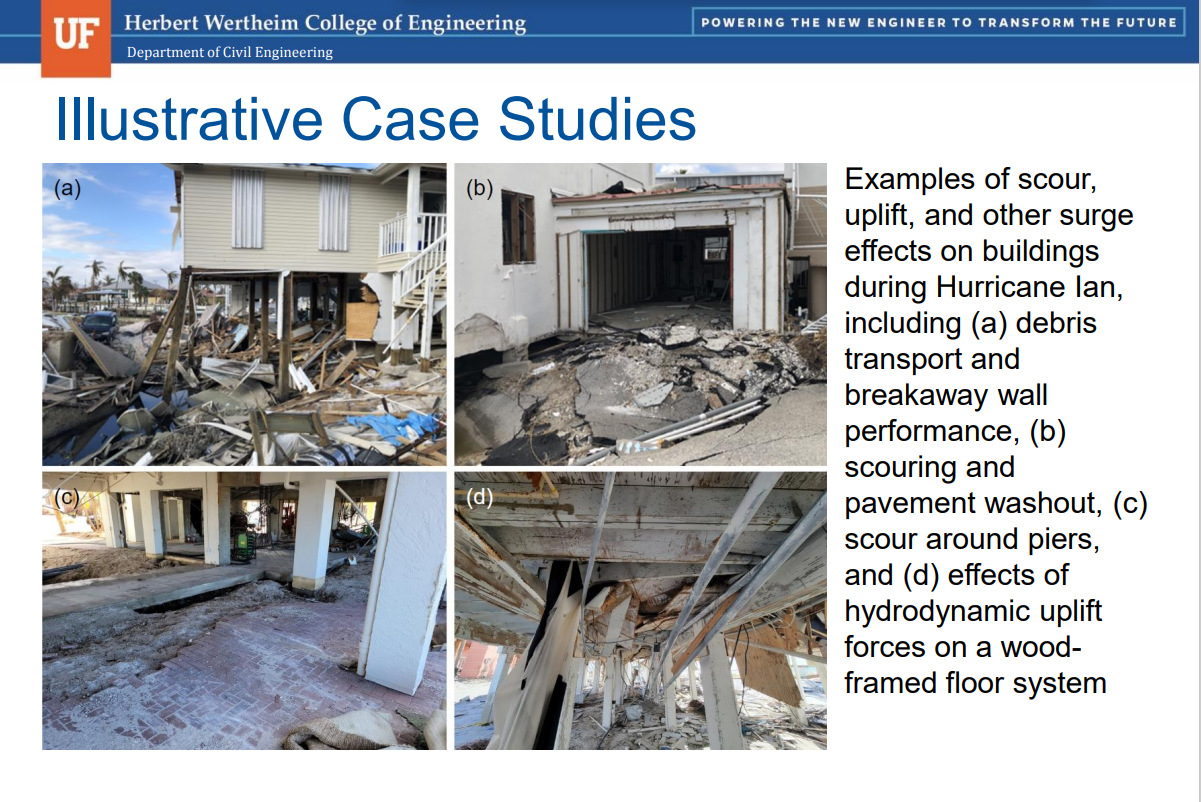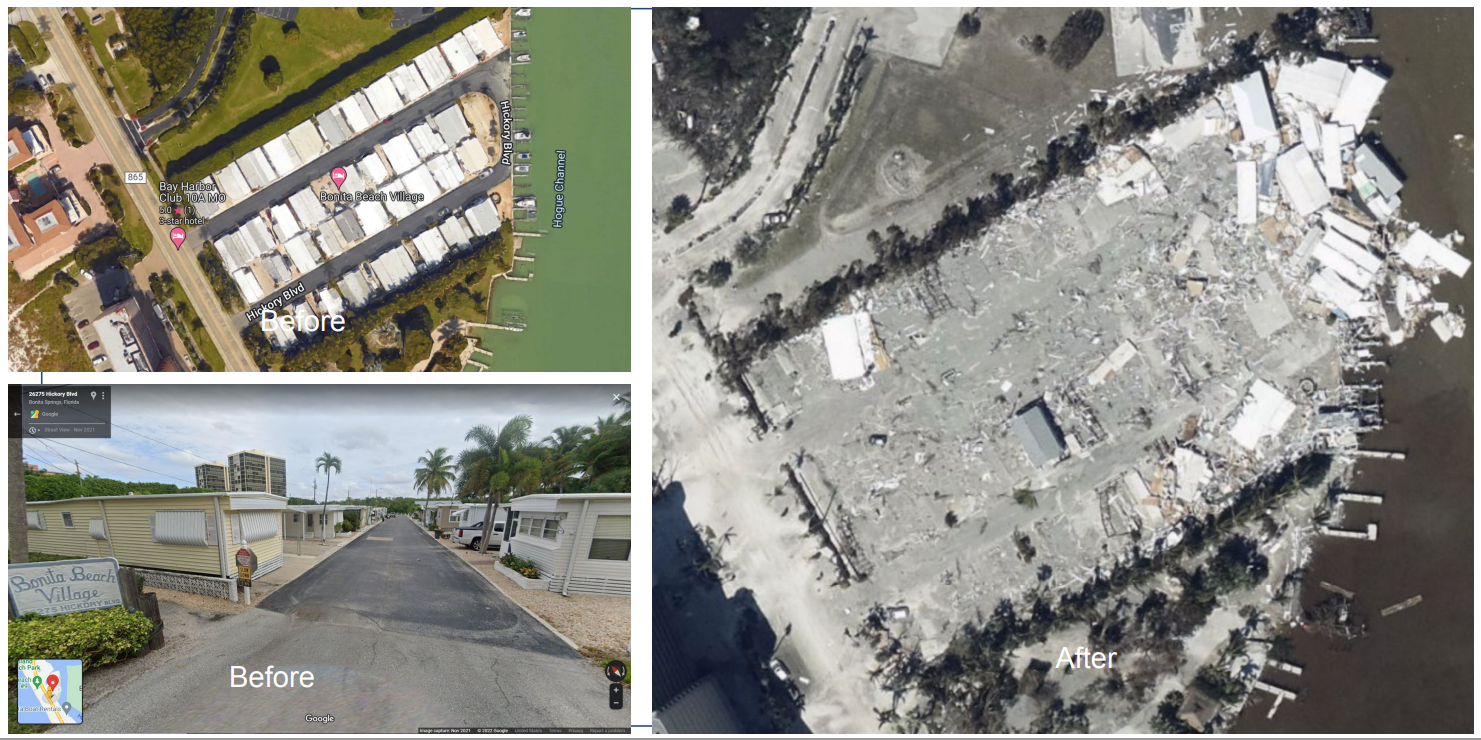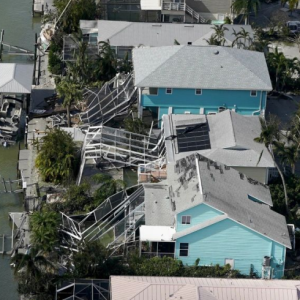An interim report submitted to the Florida Building Commission says that Southwest Florida coastal communities impacted by last September’s Hurricane Ian were “ill-prepared” for the storm surge and flooding, despite lessons on wind mitigation learned from Hurricane Charley 18 years earlier. Ian was the costliest storm in Florida history, killing 156 people and causing an estimated $109.5 billion in damage in Florida. Only an estimated half of that will be covered by insurance.
Former Florida Deputy Insurance Commissioner Lisa Miller sat down with the report’s co-author and another extreme events scientist who produced early catastrophic models on Ian for insurance companies. They discussed how this new research shows some of the same patterns of destruction seen in prior storms, that Florida hurricanes are not getting stronger or more frequent, how elderly and poor residents are disproportionately hurt, potential changes to the state building code, and why a new approach to mitigation is needed.

Dr. David O. Prevatt, Professor of Civil & Coastal Engineering, University of Florida’s Herbert Wertheim College of Engineering

Dr. Karthik Ramanathan, Vice President of Research, Verisk
Show Notes
New lessons are emerging from Hurricane Ian, the high-end Category 4 hurricane that made landfall near Fort Myers Beach on September 28, 2022. An interim report by a team of scientists supported by the Florida Building Commission showed Ian’s tropical storm-force wind field was 2.3 times the diameter of 2004’s Hurricane Charley. The greater resulting storm surge of 13 feet impacted high population areas living in both elevated and on-grade homes along hundreds of miles of canals and coastal frontage.
Findings: The report evaluates specific building code-related impacts to structural performance, including breakaway walls relative to code provisions, placement of the coastal construction control line, evidence for surge-induced floor slab uplift forces, and performance of common roof cover and wall cladding elements.
Dr. David O. Prevatt, one of the report’s co-authors, is a Professor of Civil & Coastal Engineering at the University of Florida’s Herbert Wertheim College of Engineering. He is part of the Structural Extreme Events Reconnaissance (StEER) Network of researchers and product engineers that conducts surveys to assess building performance after each hurricane. Its evaluation was used in the interim report and captured Hurricane Ian’s damage patterns and storm surge. Dr. Prevatt said Ian was not a design level wind-event, meaning its wind speed on land of about 120 mph was below the building code standards of 154-160 mph for Lee County, where it made landfall on September 28, 2022.
“The severe damage we saw was really the flooding, in particular the manufactured homes on Fort Myers Beach and mostly older slab-on-grade homes,” said Dr. Prevatt. “The good news, if there is any that we can draw from this, is that recent construction built to the recent Florida Building Code standards performed well, even in areas where they were impacted by the 13-foot high storm surge.”

Yet, Ian destroyed or severely damaged about 20,000 homes in a wide path from Lee County on the Gulf Coast and inland across central Florida to Daytona Beach on Florida’s Atlantic Coast. Dr. Prevatt said he saw the same patterns of damage in Ian that he saw in the previous six years from Hurricanes Matthew, Irma, and Michael. “It’s one of the saddest parts for me. If we don’t harden our communities or retreat and move them away from these intense events, we will repeat what we’ve seen here five, 10, 20 years down the road,” said Dr. Prevatt.
Dr. Karthik Ramanathan is Vice President of Research at Verisk, the worldwide data analytics and risk assessment firm. He led the catastrophe modeling team that estimated Hurricane Ian’s initial insurance and reinsurance losses at between $42 billion to $57 billion, not including federal flood insurance losses. The firm’s catastrophe or extreme event models not only help insurance companies determine adequate insurance premiums to the assessed value of risk and speed adjusters to the hardest hit areas right after the storm but “can also act as excellent platforms for you to test out the impact of mitigation measures,” said Dr. Ramanathan.
“As David said, the performance of manufactured homes or mobile homes continues to be a major issue, even 30 years after Hurricane Andrew, although a lot has been done to strengthen them,” said Dr. Ramanathan. “We saw a colossal amount of damage to manufactured homes. Older and middle aged homes also saw significant damage.” He and his team spent a week in South Florida after Hurricane Ian made landfall, surveying damage in both coastal and inland counties. Some inland counties he noted had “pretty staggering” claim losses similar to coastal counties near Ian’s landfall.
“Even on the wind side, some of these inland counties saw a significant amount of claims, primarily coming in from roof damage. And to me, it’s mind boggling, seeing the same state which sort of pioneered wind design, not just in the United States, but across the world, is seeing some of the same issues 30 years on in an event like Ian,” said Dr. Ramanathan.

Before and after pictures from a mobile home park in Bonita Beach, FL following Hurricane Ian. Source: NOAA
New Approaches to Mitigation: Host Miller noted that mitigation often poses a quandary for homeowners and policymakers. “We’re looking at construction costs going through the roof if we build stronger. We’re looking at property insurance premiums rising because perhaps we haven’t,” she said.
Less than two weeks after Hurricane Ian, Hurricane Nicole made landfall on Florida’s east coast with modest winds but a large storm surge, creating additional flooding and tremendous coastal erosion. Nearly 50 oceanfront homes, condominium buildings, and hotels in Volusia County either collapsed into the surf or suffered severe erosion damage.
Dr. Prevatt said the same conditions have actually existed for thousands of years in Florida.
“We have the same hurricanes today. They are no more intense. They’re not larger, nor are they more frequent than the hurricanes that have moved over the last 5,000 years. So what is happening? We have more construction. We have more people building on barrier islands. Barrier islands are called barrier islands, I think, because they were meant to protect the mainland shoreline from the storm surge, from these damages. And they’re meant to move the sand with the wind. Hurricanes are natural hazards. This is just how things are,” said Dr. Prevatt.
Florida’s population, he points out, is four times what it was in the 1970’s. “We really have to stop and ask ourselves, ‘How much further? How much money? How much federal effort should we put into securing and holding on with our own biting nails, to small pieces of land, as opposed to leaving and understanding what is happening on a natural basis?’,” Dr. Prevatt asked.
“We are building in areas where we are not supposed to build,” Dr. Ramanathan agreed, noting a Florida Department of Environmental Protection report on designated critically eroded beaches. “And further, we are building in a manner that is not necessarily resilient by putting homes on slab foundations. It is what led to a disaster that, according to my humble opinion, could have been 100% mitigated.”
Part of the mitigation challenge is that 65% of Florida’s homes were built prior to Hurricane Andrew. “New construction may be adding 2% or 3% to our housing inventory per year. So we’re just not at scale to really impact future changes in our mitigation,” said Dr. Prevatt. He said what’s needed is “research that will actually retrofit houses at scale, not one house at a time, (but) one neighborhood at a time, one town at a time.” Doing so will involve looking beyond the Bell Curve of statistics and instead disaggregating the data.
“And what you’re going to find is that the majority of this damage, disproportionately high percentages, are going to fall on the least able in our society. The poorest, the minorities, the black communities, and the tribal communities. These are the people who have been wiped out. And the retirees. Did you know that over 65% of the fatalities in Ian were over 60 years of age?” Dr. Prevatt pointed out.

Screened enclosure damage to homes in Ft. Myers from Hurricane Ian
Recommended Building Code Changes: The interim report will be updated to address questions by the Florida Building Commission that will lead to a final report, which can inform future code changes. Dr. Ramanathan believes the commission can make additional changes to the Florida Building Code beyond those mandated in recent sessions of the Florida Legislature. He said he would like to see more durable screened enclosures on homes “because if you have to replace a screened enclosure, you’re looking at a claim to the magnitude of about $5,000 or $6,000 or probably higher with inflation.” He said he’d also like to see required window protection across Florida, regardless of whether the home is in a designated wind-borne debris region, “which don’t cost a lot to install.” Finally, although manufactured homes fall under federal HUD standards, he said states can add local amendments.
“I hope, as David said, if the foundation designed for manufactured homes can be looked at closely and even more importantly, if they can be enforced to the same degree as some of the other regular single family home enforcements take place in Florida, I think it will go a long way in mitigating damage following such events,” said Dr. Ramanathan.
Dr. Prevatt said he wouldn’t look to the Florida Building Code for short-term changes, but rather a bigger picture of how to create a resilient community born in the 22nd Century. “I would spend my time in the interdisciplinary research between the economics, urban planning, and engineering analysis that will be necessary for us to re-site our coastal residential communities inland on a macro level.“ Included in that would be converting coastal land to other uses, finding ways to buy-out private properties, and moving entire communities to safer areas, he said.
“If we engineers continue to do the same type of research for the next 20 years in the same type of way, we will still end up with the same result. We have to think way bigger, we have to be grand, we have to be bold, and we have to go out there and do this. This is a moonshot moment. This is the time that Florida needs to step up and change it all,” said Dr. Prevatt.
Dr. Ramathan said Verisk does a lot of community outreach, through its work with extreme event models. “In fact, one of our missions is to promote global resilience. Because insurance, the way I look at it, is the best form of mitigation if used properly,” said Dr. Ramanathan.
Host Miller pledged to work with the “dynamic duo” of guests and the listening audience to expand the outreach of this critical scientific research to better educate local, regional, and state policymakers, as well as federal officials.
Links and Resources Mentioned in this Episode
Interim Report: Survey and Investigation of Buildings Damaged by Hurricane Ian (University of Florida Engineering School of Sustainable Infrastructure and Environment, April 17, 2023)
Dr. Prevatt slide presentation of Interim Report to the Florida Building Commission (May 10, 2023)
Preliminary Virtual Reconnaissance Report (Structural Extreme Events Reconnaissance Network, November 17, 2022) (Scroll down to the “Documents” section and click “View Data” to reveal the three PVRR PDF reports)
Priority Research Areas: Hurricane Ian (StEER Network, November 16, 2022)
Estimated Industry Insured Losses to Onshore Property for Hurricane Ian (Verisk, October 2, 2022)
Florida Senate Community Affairs Committee meeting on the Champlain Towers South Condominium collapse in Surfside, Florida |video of meeting | Florida Building Commission meeting materials (The Florida Channel, January 24, 2023)
Critically Eroded Beaches in Florida (Florida Department of Environmental Protection, June 2022)
Florida Designated Wind-borne Debris Regions (Florida Building Commission, as of December 2020)
Early Lessons from Ian’s Damage (LMA Newsletter of 12-5-22)
Safeguarding Tomorrow Revolving Loan Fund Program (FEMA, December 21, 2022)
Ian Was Costliest Florida Hurricane (LMA Newsletter of 4-10-23)
All of Florida is at risk of hurricanes. So why aren’t impact windows or shutters required statewide? (Sun Sentinel, February 5, 2023)
** The Listener Call-In Line for your recorded questions and comments to air in future episodes is 850-388-8002 or you may send email to [email protected] **
The Florida Insurance Roundup from Lisa Miller & Associates, brings you the latest developments in Property & Casualty, Healthcare, Workers’ Compensation, and Surplus Lines insurance from around the Sunshine State. Based in the state capital of Tallahassee, Lisa Miller & Associates provides its clients with focused, intelligent, and cost conscious solutions to their business development, government consulting, and public relations needs. On the web at www.LisaMillerAssociates.com or call 850-222-1041. Your questions, comments, and suggestions are welcome! Date of Recording 2/18/2023. Email via [email protected] Composer: www.TeleDirections.com © Copyright 2017-2023 Lisa Miller & Associates, All Rights Reserved

